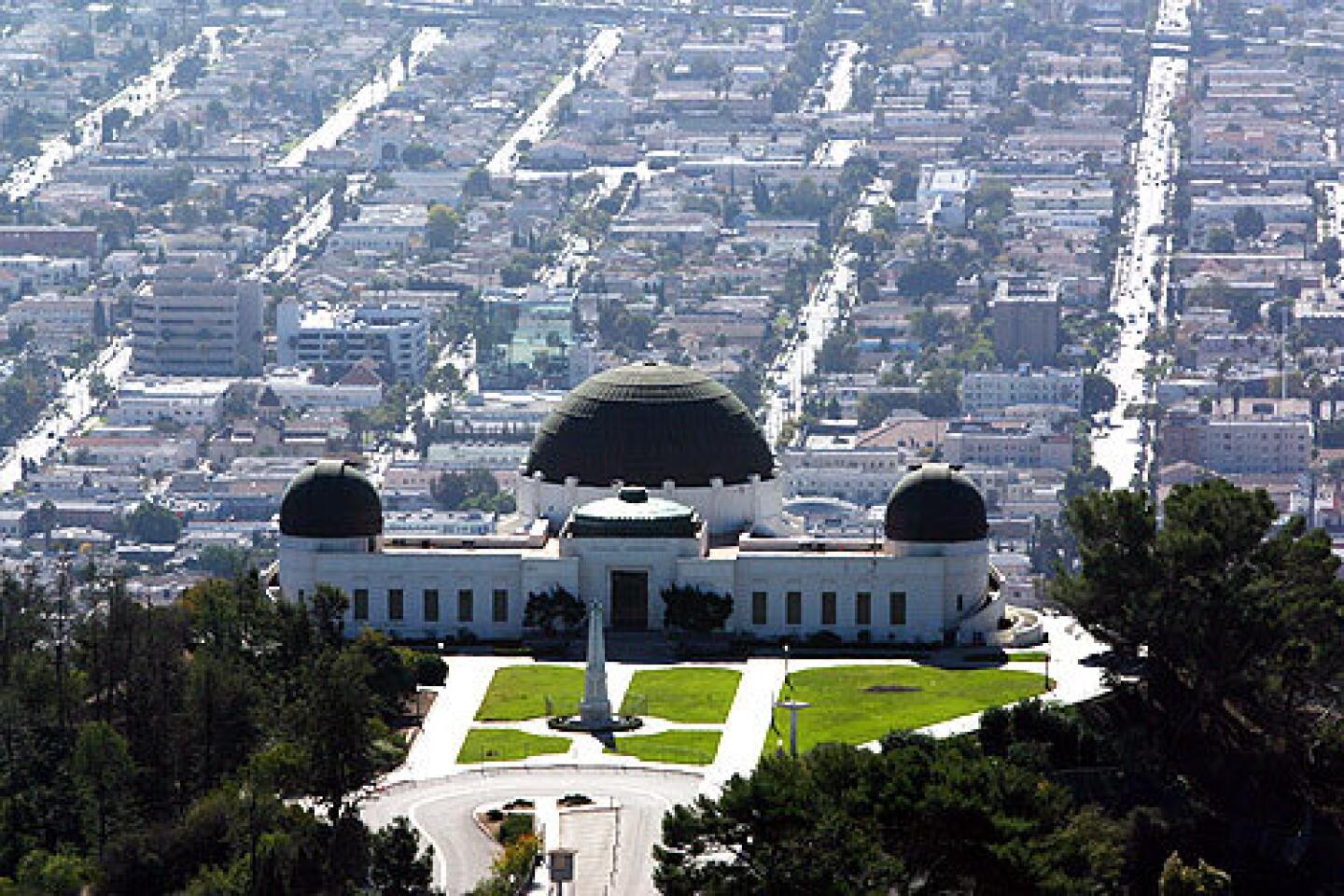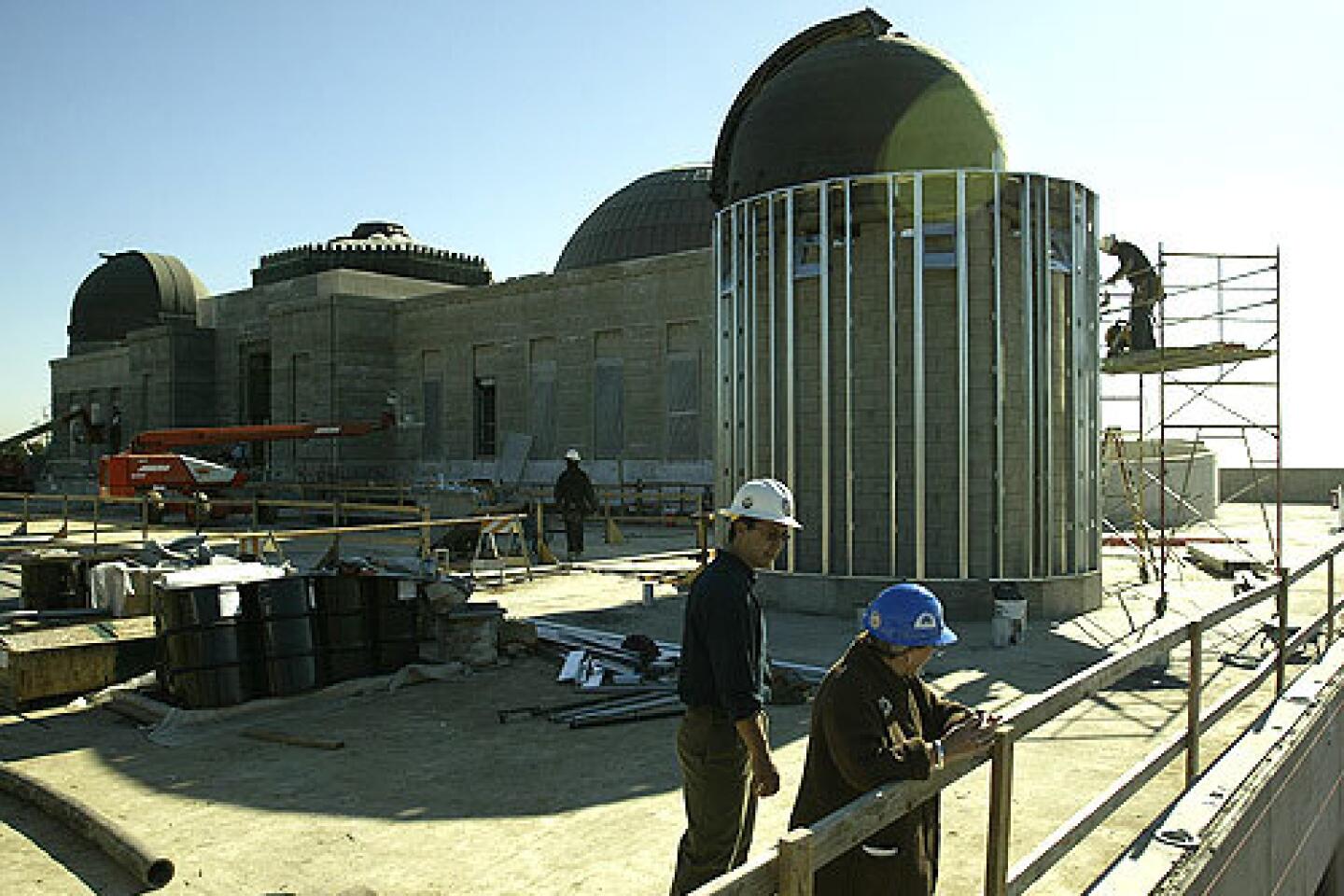Taking the Wraps off the Observatory
- Share via
Standing before the copper-domed landmark that has perched upon the Hollywood Hills since 1935, Mayor Antonio Villaraigosa today unveiled a restored and expanded Griffith Observatory and said it would reopen to the public Nov. 3.
The announcement followed nearly five years of closure and a $93-million restoration that more than doubled the size of a facility that longtime observatory director Edwin Krupp likes to call “the hood ornament of Los Angeles.” Yet the changes remain nearly invisible from a distance.
Indeed, the first major change facing new visitors will be the logistics of arrival.
Fearing traffic jams, the city has closed the 199-space lot at the observatory and will instead require that visitors make time-certain advance reservations and, in most cases, use shuttle buses based at the Hollywood-Highland mall and Los Angeles Zoo parking lots. The shuttles are expected to charge $8 per adult, $4 for children ages 5 to 12.
Observatory admission will remain free — as donor Griffith J. Griffith stipulated in his will nine decades ago — for those who walk or bicycle to the site, up to 1,320 per day.
Built in 1935, the observatory building was prominently featured in the 1955 James Dean film “Rebel Without a Cause,” and turns up again in 1984’s “Terminator” as the spot where California’s governor-to-be, portraying a killer cyborg, first materializes on Earth. Until it closed for upgrades in January 2002, the site was drawing nearly 2 million visitors a year.
In defiance of Hollywood tradition, the landmark’s keepers have labored mightily to keep improvements invisible from a distance; to add bulk to the building’s slim figure wherever possible; and in the planetarium that is the building’s central venue, to cut seating in half.
“We didn’t need more visitors,” explained Krupp, an author, UCLA astronomy Ph.D. and showman who has run the observatory since 1974. “What we needed to do is make it more satisfying for visitors.”
When the building closed in 2002, leaders of the upgrade forecast three years of work and a $66-million bill. But the expansion involved jacking up the old building while digging a new level beneath — a job made more ticklish by the building’s hillside location. In the end, workers boosted the building’s interior space from 27,000 square feet to 67,000.
Architect Stephen Johnson of Pfeiffer Partners, who began planning the project about 10 years ago with architect and preservation specialist Brenda A. Levin of Levin & Associates, called the underground work the greatest challenge of the job.
Money for the project came from a broad mix of public and private sources, beginning with $28.5 million approved by local voters through the county’s 1992 Proposition A and the city’s 1996 Proposition K. Another $26.4 million came from the city, along with $7.5 million from the state. Private donors, led by the Mr. and Mrs. Samuel Oschin Family Foundation and courted by the Friends of the Observatory, kicked in more than $30 million.
Much of their money went to upgrade features that hadn’t been replaced in decades. With tongue in cheek, Krupp recently confessed to fears that the planetarium’s old wooden headrests may have violated the Geneva Convention. He also said that by the time the observatory closed, his staff had positioned 200 buckets throughout the building to catch leaks.
Those buckets may be banished now, but the logistics of arrival will loom large in the building’s new life, especially the busy months once it reopens. Most visitors to the grounds will have to make reservations via www.griffithobservatory.org
City officials have predicted that most visitors will spend at least two hours at the reopened site, twice the time spent by most visitors before the upgrade. Through the advance reservation system, city officials say they’re setting a ceiling of about 1,800 visitors at a time and about 8,000 per day. The system is expected to remain in place for about a year, until demand eases.
The observatory’s new features include 60 exhibits addressing tides, seasons and phases of the moon and other astronomical subjects. Some have been added to the building’s ground floor, but the greatest concentration of new features lies below in the new Gunther Depths of Space exhibit hall.
That area, which was carved out of the hillside, includes “the big picture,” a 20-by-152-foot photomural (2.46 gigapixels) that depicts a million galaxies, none visible to the naked eye; and a series of displays on the planets.
Next to the planets, in a circular sheath suggestive of the sun, stands the 200-seat Leonard Nimoy Event Horizon Theater, which got its name after a million dollar donation by Nimoy and his wife, Susan Bay Nimoy, in 2001.
As for the Samuel Oschin Planetarium, whose dome is the building’s dominant element, Krupp said, a reduction from 600-plus seats to 300 well-padded, more widely spaced seats is part of the push to upgrade the quality of the experience.
Other improvements include the arrival of a new Zeiss projector from Germany; the raising of a new perforated steel interior dome to serve as projection surface; and a new main show, the 22-minute “Centered in the Universe,” written by Krupp; the observatory’s astronomical artist, Don Dixon; and Andre Bormanis, a veteran story editor and science consultant to television’s “Star Trek” franchise.
Despite a trend toward recorded presentations at planetariums elsewhere, Krupp said, the show is to be narrated by live lecturers here because “this place isn’t about astronomy. It’s about astronomy and people.”
Still, the new version has raised a ruckus among some longtime lecturers. They complain that the observatory is recruiting actors, paying less and requiring less astronomical background, effectively “dumbing down” the program.
“The observatory has gone Hollywood,” said John Sepikas, an astronomy professor at Pasadena City College who has served as a part-time observatory lecturer for about 20 years.
Also, the observatory’s Laserium light-and-sound shows have left the building. That presentation, which began the year that Pink Floyd released its “Dark Side of the Moon” album, evolved to include all sorts of other music over the next 28 years, but the private company that produced it was not invited back.
Among the building’s other new features: an eatery dubbed The Café at the End of the Universe, operated by Wolfgang Puck; five new doors and an expanded east terrace to ease foot traffic; added restrooms; an enlarged gift shop; and an elevator that gives wheelchair users rooftop access for the first time. The rooftop Zeiss telescope remains out of reach to those in wheelchairs, but the observatory’s main level offers a live video feed of the same view.
christopher.reynolds@latimes.com
More to Read
Sign up for Essential California
The most important California stories and recommendations in your inbox every morning.
You may occasionally receive promotional content from the Los Angeles Times.

















